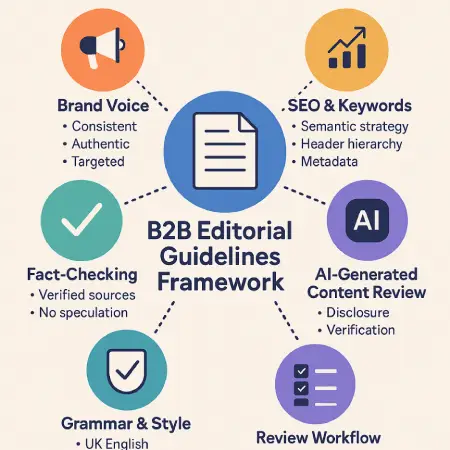In the B2B world, every word counts. You’re not just marketing a product or a service, you’re building trust with decision-makers who have limited time and a long list of vendors vying for their attention. So how do you make your content stand out? With clear, consistent, and credible editorial guidelines.
That might sound dry, but it’s anything but. Editorial standards are what keep your whitepapers tight, your emails engaging, and your thought leadership pieces from sounding like, well, everyone else’s.
Let’s break down the what, why, and how of B2B editorial guidelines, with practical takeaways, real trends, and examples you can actually use.
Why Editorial Guidelines Matter for B2B Brands
Think of your editorial guidelines as your brand’s content GPS. They ensure that:
- Your voice sounds like you no matter who writes the piece
- There’s consistency across blog posts, reports, and decks
- Complex topics are explained clearly and accessibly
- Your credibility doesn’t get undermined by basic errors
In B2B, where trust and expertise drive conversions, strong editorial guidelines are not just a nice-to-have, they’re a growth lever. We have considerable experience in this area; if you want inspiring ideas, please see our website.
A flat-style visual titled ‘B2B Editorial Guidelines Framework’, showing interconnected components like Brand Voice, SEO, Fact-Checking, and Review Workflow around a central editorial document, to illustrate how B2B brands maintain clarity, accuracy, and trust.

Source: Inkorporated
6 Must-Have Elements of Strong Editorial Guidelines
Here’s what your editorial playbook should include (and why each part matters):
1. Brand Voice and Tone
Your tone is how your brand shows up in conversation. Are you direct and data-driven? Friendly and helpful? Sharp and witty?
Document your voice with examples. For instance:
- Do: “Here’s what this trend means for your team”
- Don’t: “We humbly submit our thoughts for your consideration”
And remember: tone should adjust subtly based on the channel (email vs. whitepaper vs. social).
2. Grammar and Style Rules
Get the basics right. No one will trust your “insightful framework” if your subject lines are full of typos. Define your approach to:
- Punctuation and capitalisation
- Use of contractions (it’s fine to use “we’re”!)
- American vs British English (and stick with one)
- Jargon and acronyms (spell them out once!)
Pro tip: Build your base on an existing guide like AP or Chicago, but tweak it to suit your brand.
3. Formatting for Scannability
B2B readers are often scanning, not reading. Your content should work for them. Make it:
- Chunked into short paragraphs (2-4 lines)
- Headline-driven (H2s and h3s for structure and SEO)
- Bullet-heavy where appropriate
- Highlighted with callouts, quotes, or stats
Also, include writing templates for blog posts, emails, case studies, and more.
4. SEO and Internal Linking
This is where editorial meets performance. Don’t write for Google, but do make it easy for Google to find and understand your content.
Editorially, that means:
- Using long-tail keywords in headlines and subheads
- Including semantically related phrases throughout
- Adding internal links to relevant content (like this one on smart email marketing)
- Using alt text and meta descriptions for images
Want your content to show up in voice search? Structure it with clear, question-style H2s.
5. Credibility and Trustworthiness
Your readers are often decision-makers. They’re evaluating not just what you say, but how well you back it up.
Your editorial guidelines should emphasize:
- Citing reputable sources
- Avoiding exaggerated claims (skip “revolutionary” unless you really mean it)
- Attributing quotes and data
- Use facts, not fluff. In 2025, with AI-generated content everywhere, originality and citations are credibility.
6. Accessibility and Inclusivity
Writing for B2B doesn’t mean writing for just one demographic. Your content should:
- Use gender-neutral language
- Avoid ableist metaphors (“crazy fast” or “lame idea” are off the list)
- Include alt text on all visuals
- Follow plain language principles, especially in technical content
It’s not just ethical. It’s better writing.
Trends Shaping Editorial Guidelines in 2025
Editorial standards aren’t static. Here are some trends to weave into your current guide:
AI-Aware Editing
With generative AI becoming part of content workflows, editorial teams must add rules around:
- Verifying AI-generated content
- Rewriting robotic phrases for human tone
- Flagging hallucinated facts (they happen!)
Add a section on “Reviewing AI-generated content” to your guide.
Search-Centric Structuring
Search engines now favor structured, semantically rich content. That means:
- H1s for titles
- H2s for questions/primary ideas
- h3s for supporting points
- FAQ-style sections to capture rich snippets
Semantic structure boosts both readability and ranking.
Personalized Content, Automated at Scale
Email marketing has become smarter. With tools like HubSpot, Mailmodo, and Customer.io, personalized newsletters are now expected.
Make sure your editorial guidelines specify:
- Personalization best practices (e.g., name, industry, pain point)
- Subject line tone and character limits
- Rules for AI-generated email copy
(And yes, all of this needs editorial oversight!)
Multi-Format Publishing
Your blog is not the only place your content lives. Modern editorial guides must include standards for:
- LinkedIn carousels
- Podcast scripts
- Webinar decks
- Video subtitles and transcripts
Each of these requires consistent tone and structure.
What Do Modern B2B Editorial Guidelines Look Like?
Keep it lean but useful. The best guides are:
- 8-12 pages or one Notion board
- Full of examples, not just rules
- Shared across departments (sales, support, product)
- Reviewed quarterly to reflect new trends/tools
Want to see this in action? Take a look at how we help research teams maintain quality in our blog: How Academic Editorial Services Help Research Get Published
Final Word: Leverage Editorial Guidelines for Growth
Solid editorial guidelines are more than grammar rules, they’re your brand’s content DNA. They shape how you speak to your audience, how credible you sound, and how effective your messaging is.
If you’re a growing B2B brand trying to scale your content, now’s the time to document, refine, and share your editorial playbook.
Or better yet, build it with a team that understands content, branding, and business impact.

